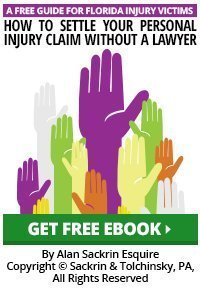Last Update: 01/05/16
One benefit of Florida’s sunny climate, is that year-round you will find lots of people walking alongside our streets and roadways. In marketing terms, people who walk near stores or restaurants are referred to as “foot traffic”. In legal jargon, people who are walking and are injured by a car or other motorized are called “pedestrians”; pedestrian accidents happen at various locations on our streets and roadways.
What is the Mid-Block, or Dart and Dash, Pedestrian Accident?
Pedestrian accidents happen in all sorts of ways, so much so that the insurance industry has gone so far as to categorize the various kinds of walking accidents involving motorized vehicles. There are bus-related pedestrian accidents, for instance, as well as the the middle-of-the-block (mid-block) or “dart and dash” pedestrian accidents (which is common for young kids and teenagers).
In a mid-block pedestrian accident, the injured person is walking (or running) near a traffic path and is hit by a vehicle when he or she goes into the roadway; simply stated, the injured walker enters the roadway in the middle of the block and into the path of the car, truck or minivan that hits them.
Common scenarios here are kids and teenagers playing soccer, football, or baseball near a street and one of the players chases after a ball and enters the street mid-block to go after it or the shopper, movie-goer, or tourist who decides to cross the roadway mid-block rather than walk down to the corner of the block to cross the street.
Who is at Fault in a Mid-Block Pedestrian Accident?
When someone is hurt in a mid-block pedestrian accident, the insurance company for the driver whose vehicle struck the victim will be looking to find ways to assert fault against the pedestrian. For instance, they may use accident reconstruction experts to argue that the driver’s view of the accident scene was blocked and it was impossible for the driver to evade hitting the victim.
They may also argue that there are traffic laws requiring the pedestrian to cross roadways at the corner or where there may be a pedestrian crossing signal. That argument is simple; the injured person caused the accident by breaking safety laws designed to prevent this sort of thing.
What is The Pedestrian Traffic Law That Applies to a Mid-Block Crossing Accident?
There are laws on the books that guide how people are supposed to cross streets and enter roadways in Florida. Florida Statute 316.130, for instance, makes it illegal for a pedestrian in Florida to:
- Suddenly leave a curb or other place of safety and walk or run into the path of a vehicle which is so close that it is impossible for the driver to yield (Florida Statute 316.130(8));
- Not yield the right of way to all vehicles in the roadway when crossing a roadway at any point other than within a marked crosswalk or within an unmarked crosswalk at an intersection (Florida Statute 316.130(10));
- Cross at any place except in a market crosswalk between adjacent intersections at which traffic control signals are in operation (Florida Statute 316.130(11)); and
- Cross a roadway at any other place than by a route at right angles to the curb or by the shortest route to the opposite curb unless it’s a marked crosswalk.(Florida Statute 316.130(12)).
How Can The Pedestrian Fight Back Against the Finger Pointing in a Mid-Block Crossing Accident?
Regardless of the arguments of insurance adjusters, the pedestrian may not be 100% to blame for the accident. Fault, and the allocation of fault, can be a complex determination in a pedestrian accident.
Sure, a child may have chased a ball out into the road, but was the car who hit the child speeding at the time? Was the driver on their cell phone? Was the driver eating a burger while driving, or putting on make-up? What exactly was the driver doing at the time of the accident?
There are also Florida traffic laws on the books that protect pedestrians in these situations. Consider Florida Statute 316.130(15):
Notwithstanding other provisions of this chapter, every driver of a vehicle shall exercise due care to avoid colliding with any pedestrian or any person propelling a human-powered vehicle and give warning when necessary and exercise proper precaution upon observing any child or any obviously confused or incapacitated person.
Bottom line, when you are driving a heavy machine like a car, SUV, minivan, or truck, then you are responsible for being alert for all sorts of traffic dangers. For example, if you are driving near a theater when a kid’s movie is getting out, then proper precautions are to slow down and be watchful of happy children or frolicking teenagers near traffic who might enter your path.
Drivers cannot waive responsibility for a crash by simply pointing to the fact that the pedestrian walked into the street at mid-block.
What Should You Do?
A good piece of advice if you have been harmed by a pedestrian accident, is to speak with an experienced personal injury lawyer before you file a claim to learn about some of the issues that can arise with these claims, including the type of evidence needed to prove a claim and the type and amount of damages you can recover. Most personal injury lawyers, like Alan Sackrin, will offer a free initial consultation (over the phone or in person) to answer your questions.
Related:
_______________
 Do you have questions or comments? Then please feel free to send Alan an email or call him now at (954) 458-8655.
Do you have questions or comments? Then please feel free to send Alan an email or call him now at (954) 458-8655.
